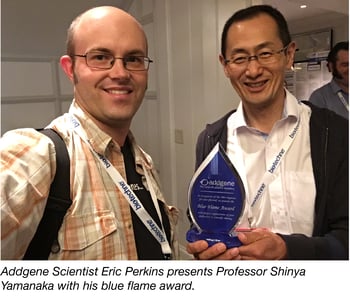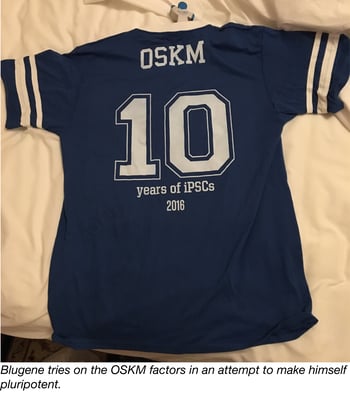 When our Director of Biology, Lianna Swanson, suggested that I might be able to attend the 10 Years of iPSCs Symposium earlier this year, I jumped at the chance. Here was an opportunity to see Shinya Yamanaka celebrate the tenth anniversary of his landmark Cell paper showing that it was possible to generate induced pluripotent stem cells (iPSCs) capable of forming nearly all cell types in the body from otherwise terminally differentiated cells simply by expressing four proteins Oct4, Sox2, Klf4, and cMyc (the so called OSKM factors). As the Yamanaka lab's primary Addgene contact for many years, I've been looking forward to seeing how the sharing of his OSKM factors have affected the stem cell community – a community largely created due to Yamanaka’s seminal work.
When our Director of Biology, Lianna Swanson, suggested that I might be able to attend the 10 Years of iPSCs Symposium earlier this year, I jumped at the chance. Here was an opportunity to see Shinya Yamanaka celebrate the tenth anniversary of his landmark Cell paper showing that it was possible to generate induced pluripotent stem cells (iPSCs) capable of forming nearly all cell types in the body from otherwise terminally differentiated cells simply by expressing four proteins Oct4, Sox2, Klf4, and cMyc (the so called OSKM factors). As the Yamanaka lab's primary Addgene contact for many years, I've been looking forward to seeing how the sharing of his OSKM factors have affected the stem cell community – a community largely created due to Yamanaka’s seminal work.
It didn't take very long to realize that the effect of Dr. Yamanaka's work has been profound, and this is a rare instance in which "profound" seems like an understatement. Multiple speakers from top minds in the stem cell field have described the Yamanaka paper as "life changing". Dr. Yamanaka himself, during his keynote address, appeared almost incredulous that the field has exploded so quickly, citing the first clinical trial with iPSCs with his collaborator Takahashi in 2014 – just 8 years after the OSKM paper – as a prime example of the fast movement in this field.
As an Addgene scientist, I'm exposed to many scientific communities, but usually I only get to scratch the surface of different fields. This meeting has given me an opportunity to dive a little deeper into the world of stem cell scientists. In my time at the meeting, I've made some observations regarding what makes this group of researchers special:
1. Stem cell scientists care deeply about ethics
 Ethics must play a prominent role in the scientific endeavor – particularly in fields like stem cell biology where questions of ethics can have profound impacts on the development of applications with the potential to save lives. While most scientists recognize and appreciate the importance of ethics, the topic can often take the back burner at scientific conferences. In my nearly 20-year career in science, I have never attended a scientific meeting that hosted an ethics panel. Scientists are known for asking "What? and "How?" , but they are not always known for asking "Should we?". Scientists are certainly having these conversations but they frequently seem to be of secondary importance (or tertiary, or non-existant). On the very first night of the iPSC symposium, a panel of thought leaders in the field--including Shinya Yamanaka, George Q. Daley, Christine Mummery, Lorenz Studer, and Deepak Srivastava--addressed a battery of questions regarding topics such as informed consent (How do we prevent stem cell lines from becoming the new HeLa cells?), genome engineering and stem cells, and the difficulty of sharing banked iPSCs across international borders.
Ethics must play a prominent role in the scientific endeavor – particularly in fields like stem cell biology where questions of ethics can have profound impacts on the development of applications with the potential to save lives. While most scientists recognize and appreciate the importance of ethics, the topic can often take the back burner at scientific conferences. In my nearly 20-year career in science, I have never attended a scientific meeting that hosted an ethics panel. Scientists are known for asking "What? and "How?" , but they are not always known for asking "Should we?". Scientists are certainly having these conversations but they frequently seem to be of secondary importance (or tertiary, or non-existant). On the very first night of the iPSC symposium, a panel of thought leaders in the field--including Shinya Yamanaka, George Q. Daley, Christine Mummery, Lorenz Studer, and Deepak Srivastava--addressed a battery of questions regarding topics such as informed consent (How do we prevent stem cell lines from becoming the new HeLa cells?), genome engineering and stem cells, and the difficulty of sharing banked iPSCs across international borders.
While questions of ethics can be daunting because they have no clear cut answers, I applaud the stem cell community for addressing these important questions that the scientific method cannot address.
Listen to Our Podcast Interview with Stem Cell Researcher Darrell Kotton
2. Stem cell scientists care about patients
As any grad student who has spent years studying how that one protein interacts with that one promoter can tell you, it can be easy to get lost in the details. The speakers at this meeting shared plenty of details, but they also uniformly stepped back to give a big picture perspective: Dr. Yamanaka talked about his clinical trial patients with advanced macular degeneration; Laurenz Studer discussed his work with Parkinson's Disease; Hideyuki Okano presented ground-breaking work on spinal cord injuries; Jessica Young shared research on stem cells and Alzheimer's Disease; and Kevin Eggan presented work that is leading to promising clinical trials for ALS.
I have an uncle with Parkinson's, a half-brother who is a quadriplegic due to a spinal cord injury, and numerous family friends who had Alzheimer's. Knowing that stem cell scientists are so focused on translational research is encouraging. Patients are key to the research, but they are also the reason this research is happening. Stem cells scientists have certainly not lost site of that.
3. Stem cell science is hard, and expensive
Dr. Yamanaka explained that it took 50 people nearly 2 years to create the first stem cell line that could be used in clinical trials. The quality control process alone takes nearly a year. Addgene depositor Juan Carlos Izpsua Belmonte said it took the joint effort of five post-docs to implant human kidney progenitors into a pig. In stark contrast to recent genome engineering technologies, stem cell techniques are neither fast nor inexpensive.
After talking to numerous poster presenters, it was gratifying to see that Addgene has ensured that plasmid acquisition is not a rate-limiting step in stem cell research. People told me they couldn't have done their work without us. When it comes to helping the stem cell community with their research, I think I can speak for Addgene when I say that I'm glad we're so fast and affordable. Something in their world should be fast and affordable.
4. Stem cell scientists are generous
Besides some of the scientists I've already mentioned, Addgene depositors Marius Wernig, Kristin Baldwin, Kathrin Plath, Hans Schöler, and closing keynote speaker Rudolph Jaenisch have also spoken at this meeting. In fact, we have so many depositors from the stem cell community that they have their own page on our website. That's amazing. Our Addgene stem cell page is proof that these researchers are thriving in a collaborative, rather than a combative, field. Of course they are competing with each other, but it's a healthy competition. What an honor for Addgene to be a part of that!
Additional Resources on the Addgene Blog
- Learn about Efforts to Fight Rare disease with iPSCs
- Read About Addgene's Outreach Efforts in the Microbiology Community
- Sign Up to Write About Stem Cells
Resources on the Addgene Wesbite
- Find Reprogramming Plasmids
- Find Other Hot Plasmid Tools
- Visit Our Stem Cell Pages
Topics: Stem Cells, Other






Leave a Comment